Assessment of Commercial GNSS Radio Occultation Performance from PlanetiQ Mission
Abstract
:1. Introduction
2. Data and Methods
2.1. GNSS-RO Data
2.2. ERA5 Datasets
2.3. Methods
3. Results and Analysis
3.1. SNR Latitudinal Distribution
3.2. Lowest Penetration Height
3.3. Assessment of PlanetiQ Refractivity Accuracy
3.4. Assessment of the PlanetiQ Temperature Accuracy
4. Conclusions
Author Contributions
Funding
Data Availability Statement
Acknowledgments
Conflicts of Interest
References
- Liu, C.; Liao, M.; Sun, Y.; Wang, X.; Liang, J.; Hu, X.; Zhang, P.; Yang, G.; Liu, Y.; Wang, J.; et al. Preliminary Assessment of BDS Radio Occultation Retrieval Quality and Coverage Using FY-3E GNOS II Measurements. Remote Sens. 2023, 15, 5011. [Google Scholar] [CrossRef]
- Zhran, M.; Mousa, A.; Alshehri, F.; Jin, S. Evaluation of Tropopause Height from Sentinel-6 GNSS Radio Occultation Using Different Methods. Remote Sens. 2023, 15, 5513. [Google Scholar] [CrossRef]
- Anthes, R.A. Exploring Earth’s atmosphere with radio occultation: Contributions to weather, climate and space weather. Atmos. Meas. Tech. 2011, 4, 1077–1103. [Google Scholar] [CrossRef]
- Steiner, A.K.; Lackner, B.C.; Ladstdter, F.; Scherllin-Pirscher, B.; Foelsche, U.; Kirchengast, G. GPS radio occultation for climate monitoring and change detection. Radio Sci. 2011, 46, 1–17. [Google Scholar] [CrossRef]
- Zhran, M.; Mousa, A. Global tropopause height determination using GNSS radio occultation. Egypt. J. Remote Sens. Space Sci. 2023, 26, 317–331. [Google Scholar] [CrossRef]
- Bai, W.; Deng, N.; Sun, Y.; Du, Q.; Xia, J.; Wang, X.; Meng, X.; Zhao, D.; Liu, C.; Tan, G.; et al. Applications of gnss-ro to numerical weather prediction and tropical cyclone forecast. Atmosphere 2020, 11, 1204. [Google Scholar] [CrossRef]
- Elrahman Yassien, A.; El-Kutb Mousa, A.; Rabah, M.; Saber, A.; Zhran, M. Analysis of spatial and temporal variation of precipitable water vapor using COSMIC radio occultation observations over Egypt. Egypt. J. Remote Sens. Space Sci. 2022, 25, 751–764. [Google Scholar] [CrossRef]
- Innerkofler, J.; Kirchengast, G.; Schwärz, M.; Pock, C.; Jäggi, A.; Andres, Y.; Marquardt, C. Precise orbit determination for climate applications of GNSS radio occultation including uncertainty estimation. Remote Sens. 2020, 12, 1180. [Google Scholar] [CrossRef]
- Foelsche, U.; Pirscher, B.; Borsche, M.; Kirchengast, G.; Wickert, J. Assessing the climate monitoring utility of radio occupation data: From CHAMP to FORMOSAT-3/COSMIC. Terr. Atmos. Ocean. Sci. 2009, 20, 155–170. [Google Scholar] [CrossRef]
- Bauer, P.; Radnóti, G.; Healy, S.; Cardinali, C. GNSS radio occultation constellation observing system experiments. Mon. Weather Rev. 2014, 142, 555–572. [Google Scholar] [CrossRef]
- Harnisch, F.; Healy, S.B.; Bauer, P.; English, S.J. Scaling of GNSS radio occultation impact with observation number using an ensemble of data assimilations. Mon. Weather Rev. 2013, 141, 4395–4413. [Google Scholar] [CrossRef]
- Anthes, R.; Sjoberg, J.; Feng, X.; Syndergaard, S. Comparison of COSMIC and COSMIC-2 Radio Occultation Refractivity and Bending Angle Uncertainties in August 2006 and 2021. Atmosphere 2022, 13, 790. [Google Scholar] [CrossRef]
- Kuo, Y.H.; Wee, T.K.; Sokolovskiy, S.; Rocken, C.; Schreiner, W.; Hunt, D.; Anthes, R.A. Inversion and Error Estimation of GPS Radio Occultation Data. J. Meteorol. Soc. Japan. Ser. II 2004, 82, 507–531. [Google Scholar] [CrossRef]
- Zhran, M. An evaluation of GNSS radio occultation atmospheric profiles from Sentinel-6. Egypt. J. Remote Sens. Space Sci. 2023, 26, 654–665. [Google Scholar] [CrossRef]
- Ho, S.P.; Zhou, X.; Shao, X.; Zhang, B.; Adhikari, L.; Kireev, S.; He, Y.; Yoe, J.G.; Xia-Serafino, W.; Lynch, E. Initial assessment of the COSMIC-2/FORMOSAT-7 neutral atmosphere data quality in NESDIS/STAR using in situ and satellite data. Remote Sens. 2020, 12, 4099. [Google Scholar] [CrossRef]
- Zhang, J.; Xu, X.; Luo, J. Estimating the observation errors of FY-3C radio occultation dataset using the three-cornered hat method. Terr. Atmos. Ocean. Sci. 2023, 34, 22. [Google Scholar] [CrossRef]
- Chen, S.Y.; Liu, C.Y.; Huang, C.Y.; Hsu, S.C.; Li, H.W.; Lin, P.H.; Cheng, J.-P.; Huang, C.-Y. An analysis study of formosat-7/cosmic-2 radio occultation data in the troposphere. Remote Sens. 2021, 13, 717. [Google Scholar] [CrossRef]
- Shao, X.; Ho, S.P.; Zhang, B.; Cao, C.; Chen, Y. Consistency and stability of SNPP ATMS microwave observations and COSMIC-2 radio occultation over oceans. Remote Sens. 2021, 13, 3754. [Google Scholar] [CrossRef]
- Cao, C.; Wang, W.; Lynch, E.; Bai, Y.; Ho, S.P.; Zhang, B. Simultaneous radio occultation for intersatellite comparison of bending angles toward more accurate atmospheric sounding. J. Atmos. Ocean. Technol. 2020, 37, 2307–2320. [Google Scholar] [CrossRef]
- Bowler, N.E. An Initial Assessment of the Quality of RO Data from PAZ. ROM SAF Report 36. 2020. Available online: https://rom-saf.eumetsat.int/general-documents/rsr/rsr_36_v11.pdf (accessed on 1 March 2024).
- Yang, M.; Meng, X.; Tian, H.; Sun, Y.; Du, Q.; Bai, W.; Wang, B.; Wang, X.; Hu, P.; Tan, G. First Galileo Single-Frequency Occultation Process and Precision Analysis of FengYun3E. Remote Sens. 2023, 15, 4410. [Google Scholar] [CrossRef]
- Ho, S.P.; Pedatella, N.; Foelsche, U.; Healy, S.; Weiss, J.P.; Ullman, R. Using Radio Occultation Data for Atmospheric Numerical Weather Prediction, Climate Sciences, and Ionospheric Studies and Initial Results from COSMIC-2, Commercial RO Data, and Recent RO Missions. Bull. Am. Meteorol. Society. Am. Meteorol. Soc. 2022, 103, E2506–E2512. [Google Scholar] [CrossRef]
- Kursinski, E.R. Weather & Space Weather RO Data from PlanetiQ Commercial GNSS RO; IROWG: Boulder, CO, USA, 2019. [Google Scholar]
- Available online: https://planetiq.com/ (accessed on 1 April 2024).
- Kursinski, E.R.; Brandmeyer, J.; Feng, X.; Giesinger, B. PlanetiQ Dual Linear Polarization GNSS Measurements in 2024 for PRO and Surface Reflections. In Proceedings of the 2nd PAZ Polarimetric Radio Occultations User Workshop, Pasadena, CA, USA, 28–29 November 2023. [Google Scholar]
- Available online: https://www.eoportal.org/satellite-missions?Mission+type=EO (accessed on 1 April 2024).
- Adhikari, L.; Ho, S.P.; Zhou, X. Inverting cosmic-2 phase data to bending angle and refractivity profiles using the full spectrum inversion method. Remote Sens. 2021, 13, 1793. [Google Scholar] [CrossRef]
- Ho, S.P.; Zhou, X.; Shao, X.; Chen, Y.; Jing, X.; Miller, W. Using the Commercial GNSS RO Spire Data in the Neutral Atmosphere for Climate and Weather Prediction Studies. Remote Sens. 2023, 15, 4836. [Google Scholar] [CrossRef]
- Gorbunov, M.; Irisov, V.; Rocken, C. The Influence of the Signal-to-Noise Ratio Upon Radio Occultation Retrievals. Remote Sens. 2022, 14, 2742. [Google Scholar] [CrossRef]
- Schreiner, W.S.; Weiss, J.P.; Anthes, R.A.; Braun, J.; Chu, V.; Fong, J.; Hunt, D.; Kuo, Y.H.; Meehan, T.; Serafino, W.; et al. COSMIC-2 Radio Occultation Constellation: First Results. Geophys. Res. Lett. 2020, 47, e2019GL086841. [Google Scholar] [CrossRef]
- Zhran, M.; Mousa, A. Planetary boundary layer height retrieval using GNSS Radio Occultation over Egypt. Egypt. J. Remote Sens. Space Sci. 2022, 25, 551–559. [Google Scholar] [CrossRef]
- Wei, J.; Li, Y.; Zhang, K.; Liao, M.; Bai, W.; Liu, C.; Liu, Y.; Wang, X. An evaluation of Fengyun-3C radio occultation atmospheric profiles over 2015–2018. Remote Sens. 2020, 12, 2116. [Google Scholar] [CrossRef]
- Yu, X.; Xie, F.; Ao, C.O. Evaluating the lower-tropospheric COSMIC GPS radio occultation sounding quality over the Arctic. Atmos. Meas. Tech. 2018, 11, 2051–2066. [Google Scholar] [CrossRef]
- Schreiner, W.; Sokolovskiy, S.; Hunt, D.; Rocken, C. Analysis of GPS radio occultation data from the FORMOSAT-3/COSMIC and Metop/GRAS missions at CDAAC. Atmos. Meas. Tech. 2011, 4, 2255–2272. [Google Scholar] [CrossRef]
- Gorbunov, M.E.; Shmakov, A.V.; Leroy, S.S.; Lauritsen, K.B. COSMIC radio occultation processing: Cross-center comparison and validation. J. Atmos. Ocean. Technol. 2011, 28, 737–751. [Google Scholar] [CrossRef]
- Lin, C.H.; Lin, J.T.; Chang, L.C.; Liu, J.Y.; Chen, C.H.; Chen, W.H.; Huang, H.H.; Liu, C.H. Observations of global ionospheric responses to the 2009 stratospheric sudden warming event by FORMOSAT-3/COSMIC. J. Geophys. Res. Space Phys. 2012, 117, A06323. [Google Scholar] [CrossRef]
- Hersbach, H.; Bell, B.; Berrisford, P.; Hirahara, S.; Horányi, A.; Muñoz-Sabater, J.; Nicolas, J.; Peubey, C.; Radu, R.; Schepers, D.; et al. The ERA5 global reanalysis. Q. J. R. Meteorol. Soc. 2020, 146, 1999–2049. [Google Scholar] [CrossRef]
- Gorbunov, M.; Irisov, V.; Rocken, C. Noise Floor and Signal-to-Noise Ratio of Radio Occultation Observations: A Cross-Mission Statistical Comparison. Remote Sens. 2022, 14, 691. [Google Scholar] [CrossRef]
- Gorbunov, M.E.; Gurvich, A.S.; Shmakov, A.V. Back-propagation and radio-holographic methods for investigation of sporadic ionospheric E-layers from microlab-1 data. Int. J. Remote Sens. 2002, 23, 675–685. [Google Scholar] [CrossRef]
- Yunck, T.P.; Liu, C.-H.; Ware, R. A History of GPS Sounding. Terr. Atmos. Ocean. Sci. 2000, 11, 1–20. [Google Scholar] [CrossRef]
- Melbourne, W.G.; Davis, E.S.; Duncan, C.B.; Hajj, G.A.; Hardy, K.R.; Kursinski, E.R.; Meehan, T.K.; Young, L.E.; Yunck, T.P. The Application ofSpaceborne GPS to Atmospheric Limb Sounding and Global Change Monitoring; JPL Publication: La Cañada Flintridge, CA, USA, 1994; pp. 18–94. Available online: https://ntrs.nasa.gov/citations/19960008694 (accessed on 1 April 2024).
- Smith, E.K.; Weintraub, S. The Constants in the Equation for Atmospheric Refractive Index at Radio Frequencies. Proc. IRE 1953, 41, 1035–1037. [Google Scholar] [CrossRef]
- Chen, Q.; Song, S.; Heise, S.; Liou, Y.A.; Zhu, W.; Zhao, J. Assessment of ZTD derived from ECMWF/NCEP data with GPS ZTD over China. GPS Solut. 2011, 15, 415–425. [Google Scholar] [CrossRef]
- Chen, Y.; Shao, X.; Cao, C.; Ho, S.P. Simultaneous radio occultation predictions for inter-satellite comparison of bending angle profiles from COSMIC-2 and geooptics. Remote Sens. 2021, 13, 3644. [Google Scholar] [CrossRef]
- Zhang, B.; Ho, S.P.; Cao, C.; Shao, X.; Dong, J.; Chen, Y. Verification and Validation of the COSMIC-2 Excess Phase and Bending Angle Algorithms for Data Quality Assurance at STAR. Remote Sens. 2022, 14, 3288. [Google Scholar] [CrossRef]
- Qiu, C.; Wang, X.; Zhou, K.; Zhang, J.; Chen, Y.; Li, H.; Liu, D.; Yuan, H. Comparative Assessment of Spire and COSMIC-2 Radio Occultation Data Quality. Remote Sens. 2023, 15, 5082. [Google Scholar] [CrossRef]
- Chang, H.; Lee, J.; Yoon, H.; Morton, Y.J.; Saltman, A. Performance assessment of radio occultation data from GeoOptics by comparing with COSMIC data. Earth Planets Space 2022, 74, 108. [Google Scholar] [CrossRef]
- Ao, C.O.; Meehan, T.K.; Hajj, G.A.; Mannucci, A.J.; Beyerle, G. Lower troposphere refractivity bias in GPS occultation retrievals. J. Geophys. Res. Atmos. 2003, 108, 4577. [Google Scholar] [CrossRef]
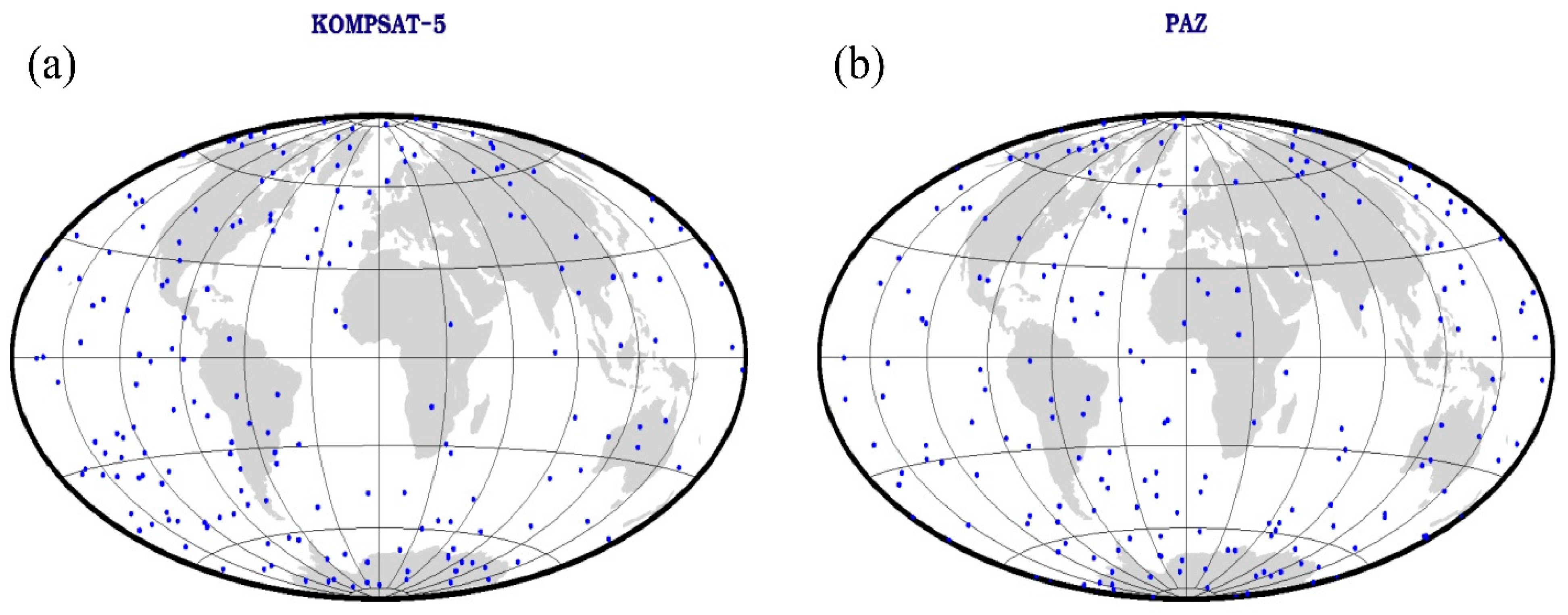
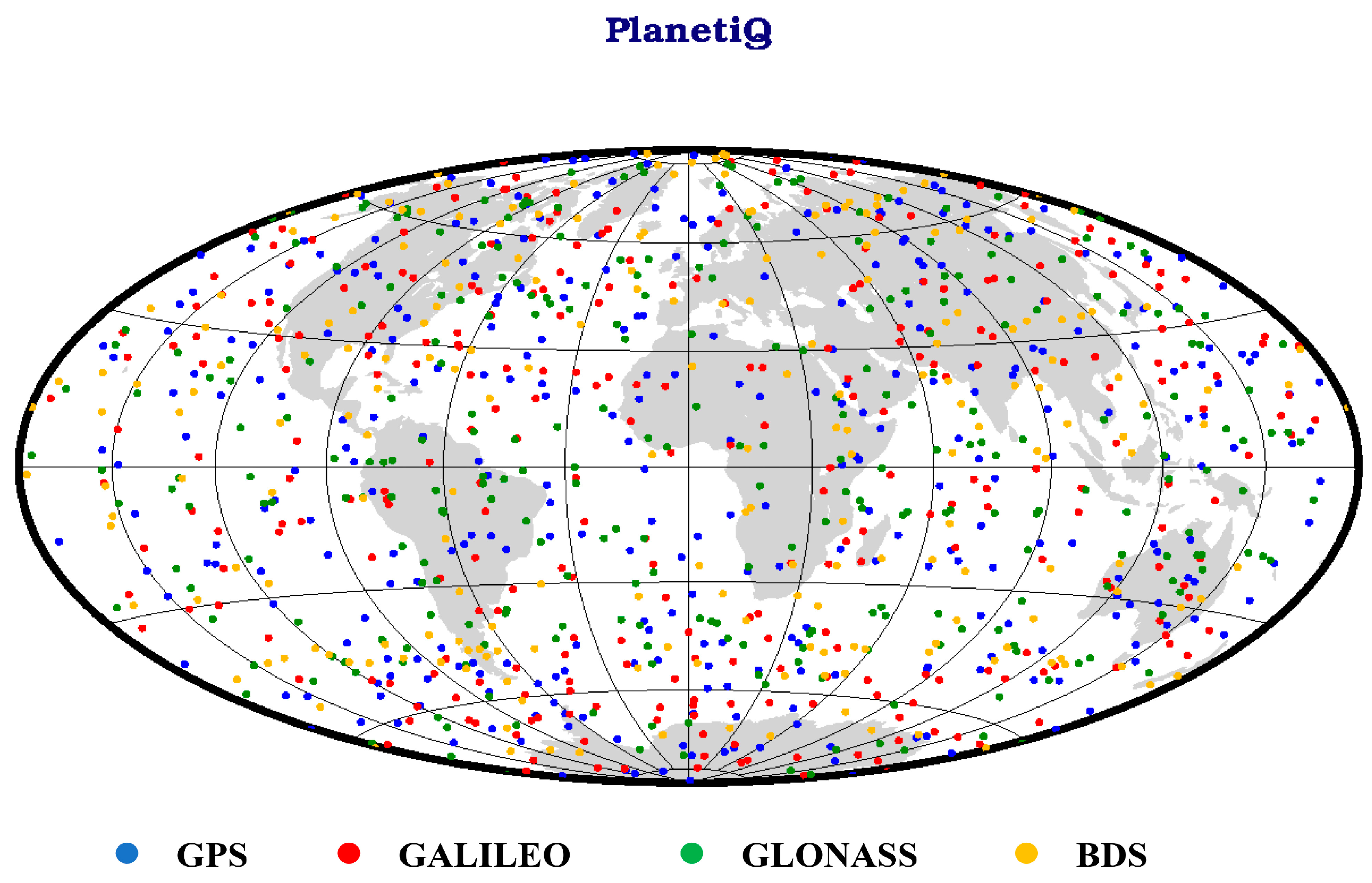


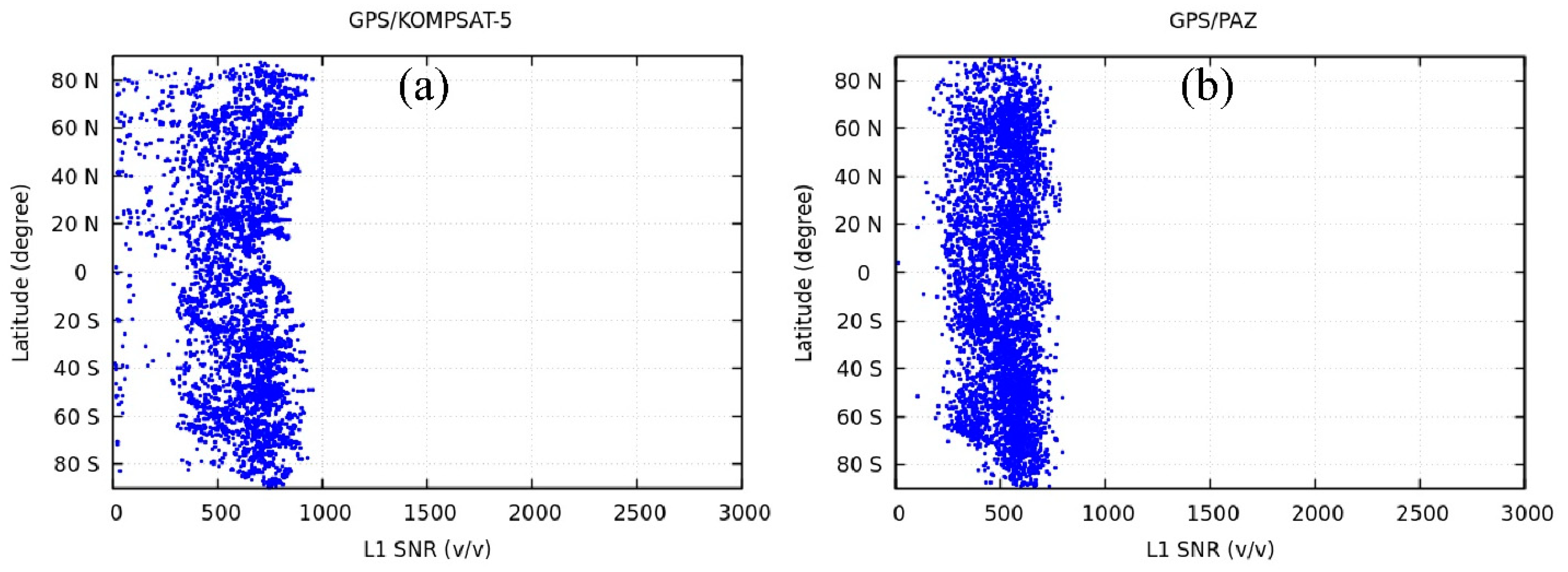
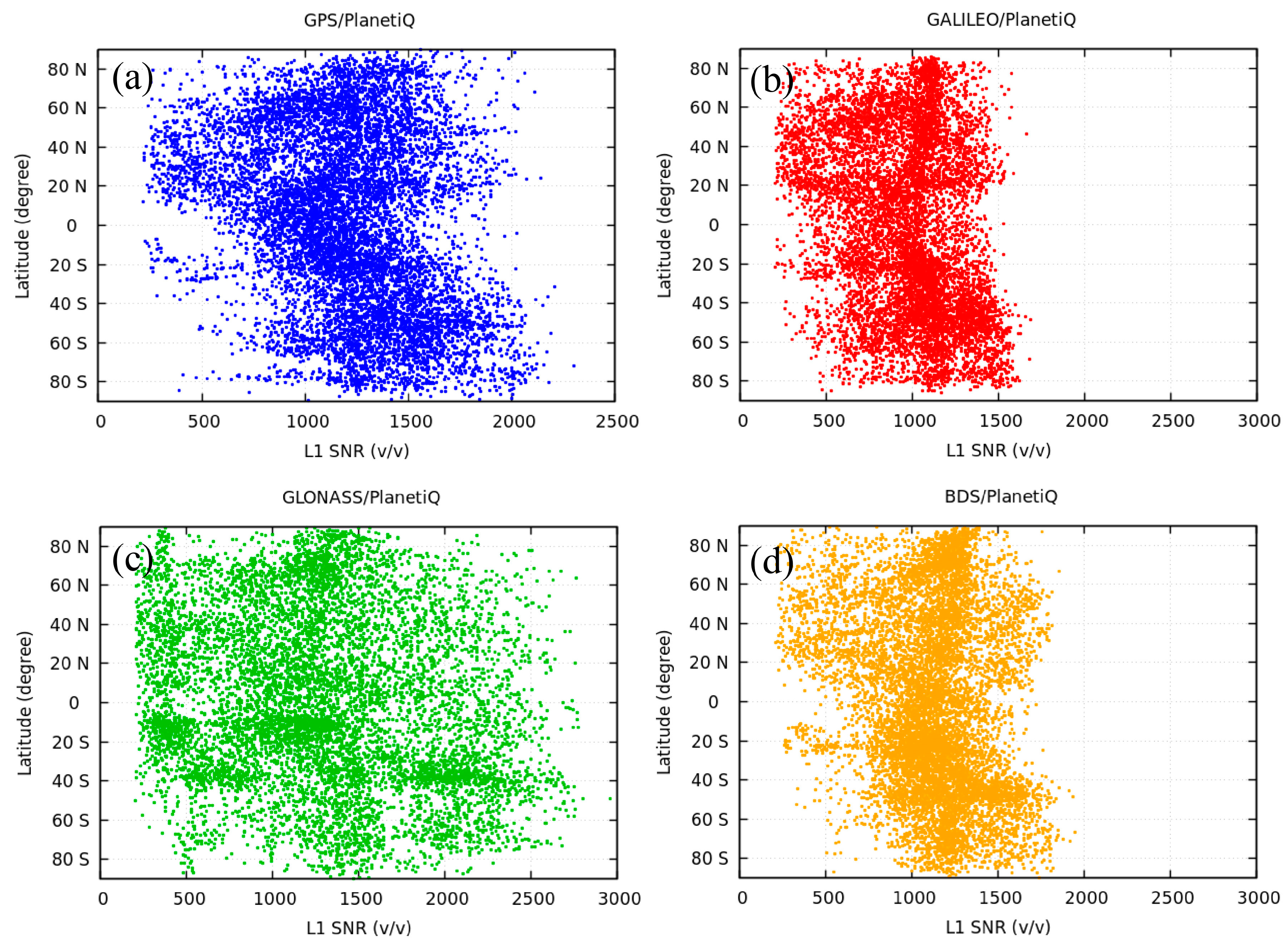
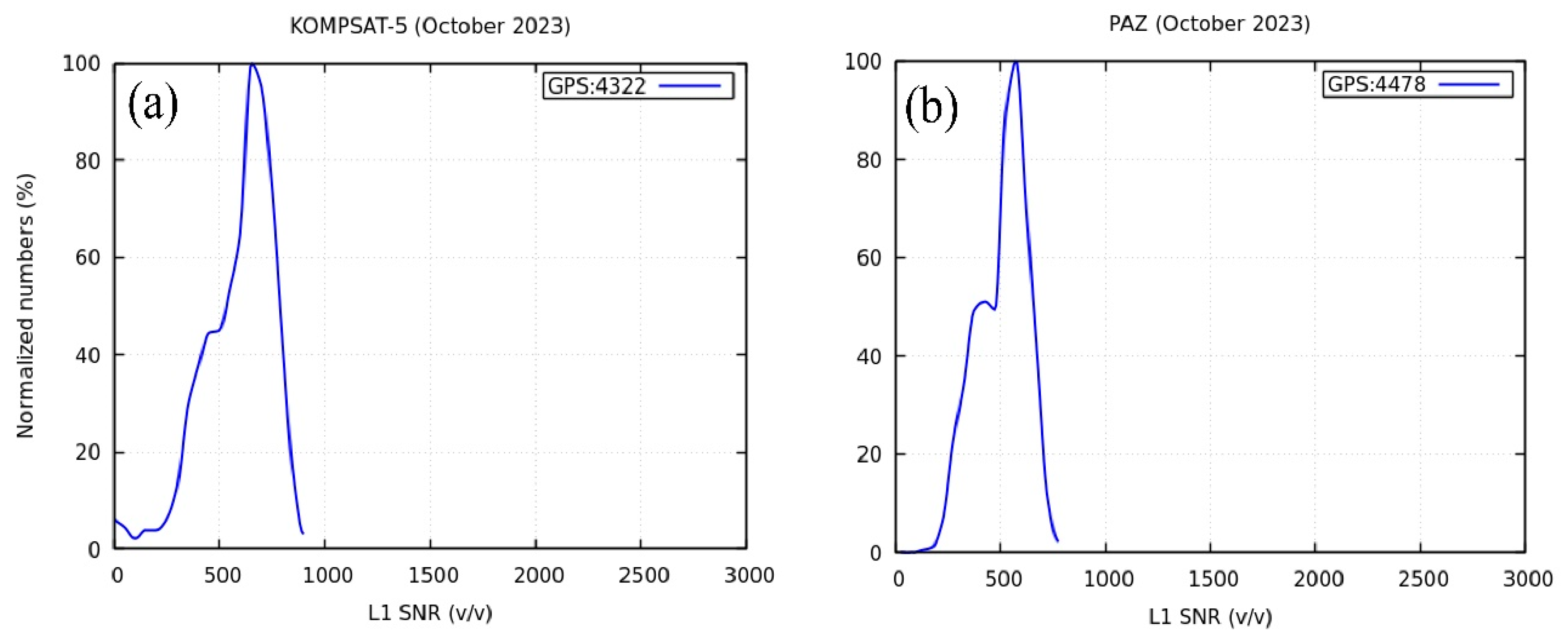
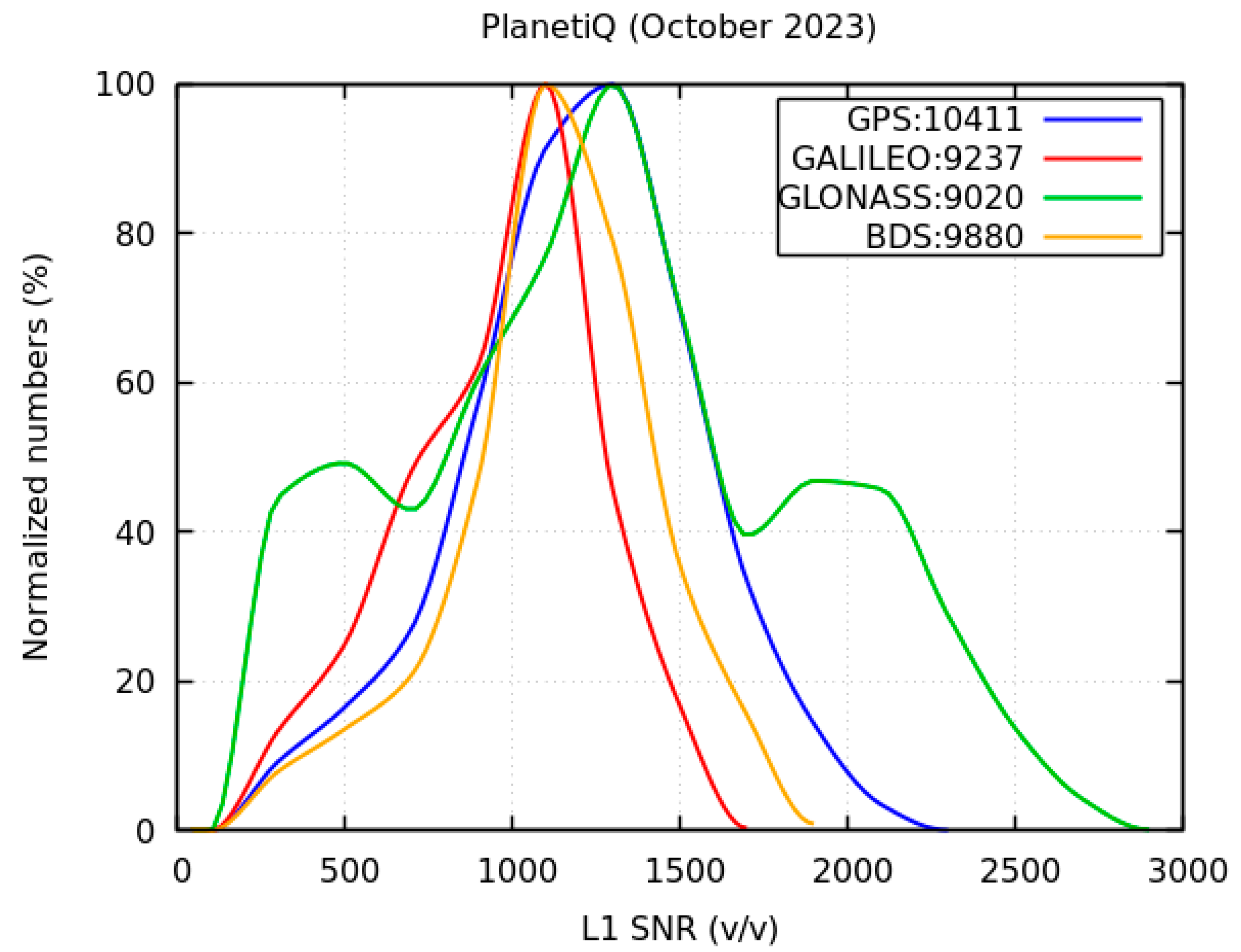
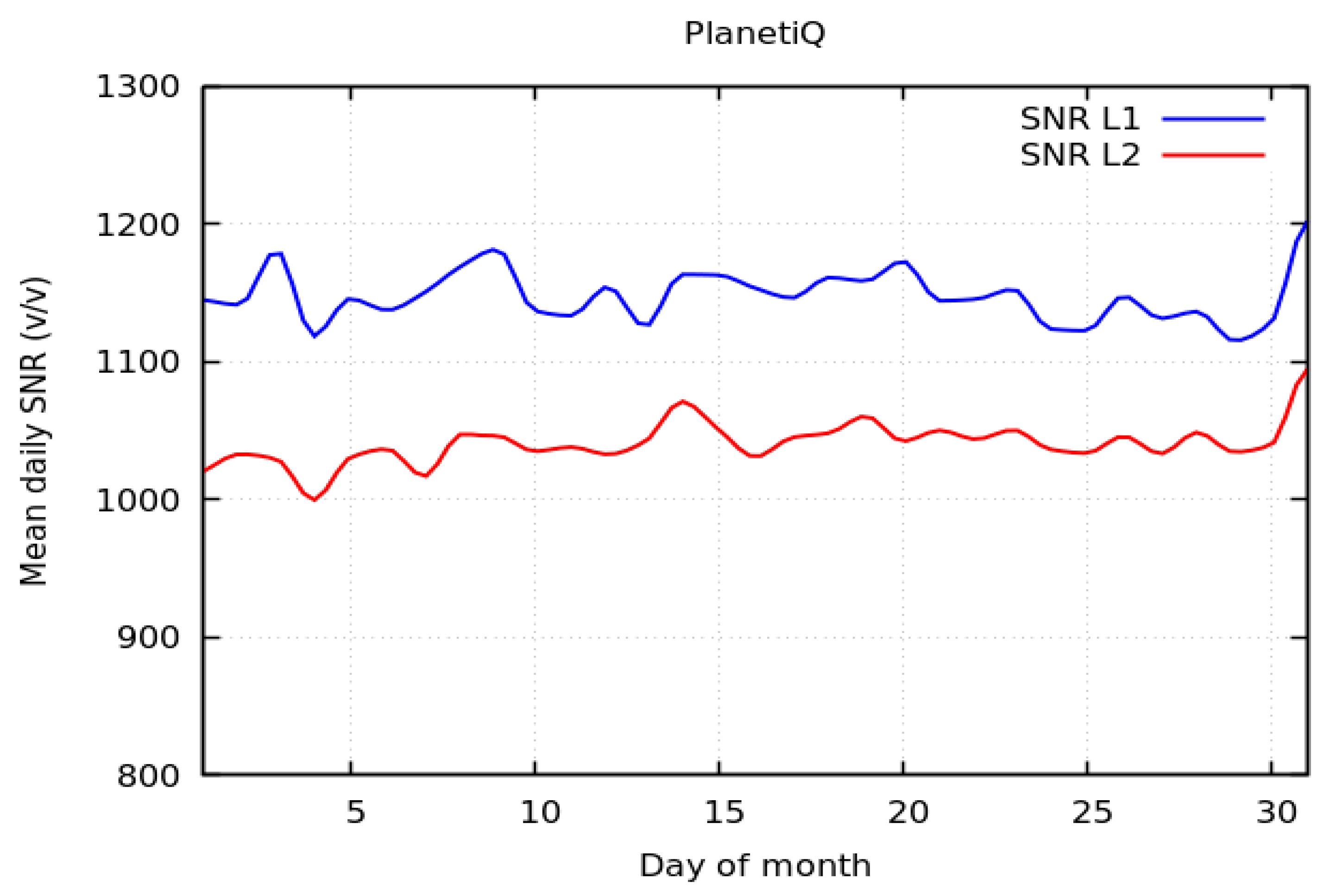
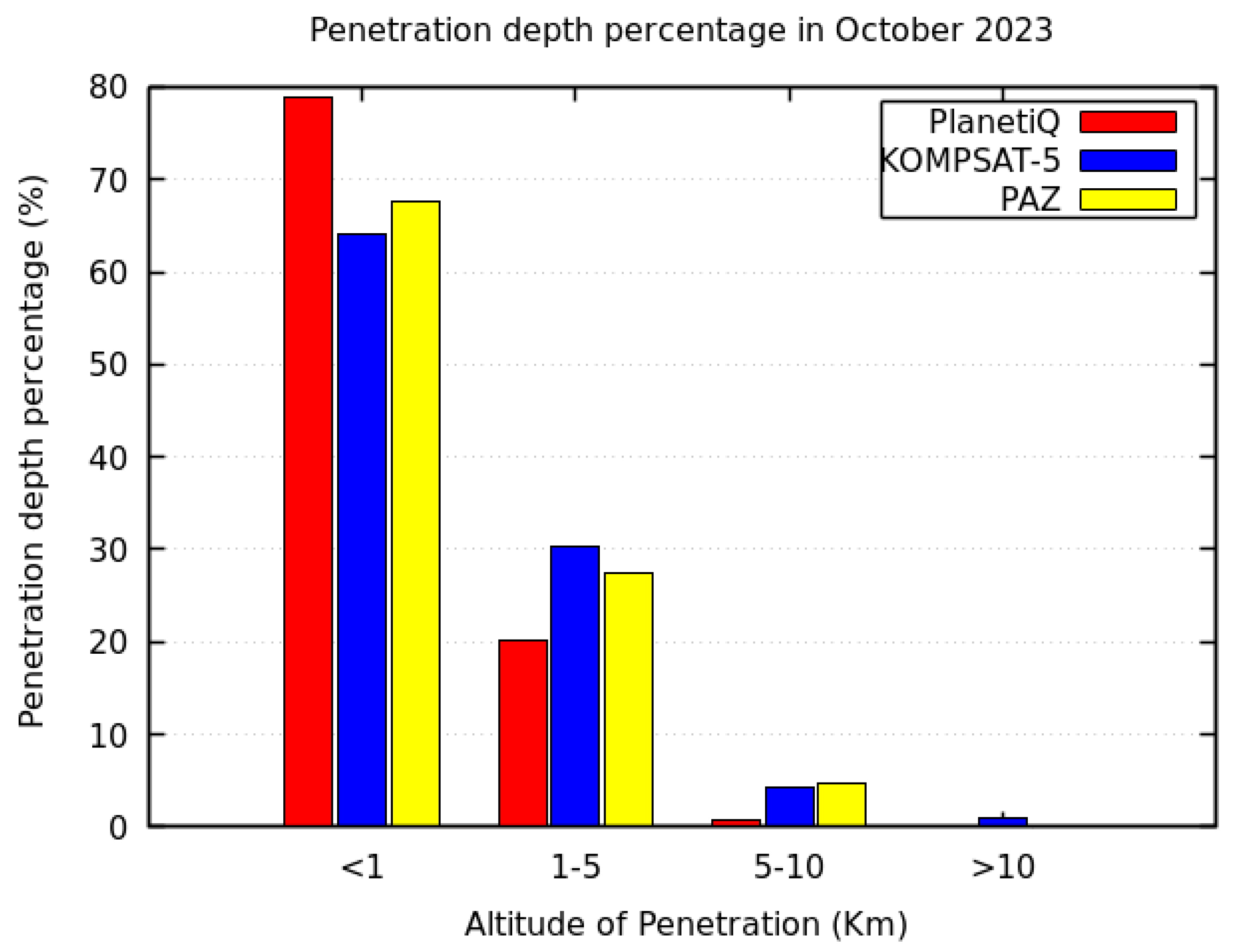

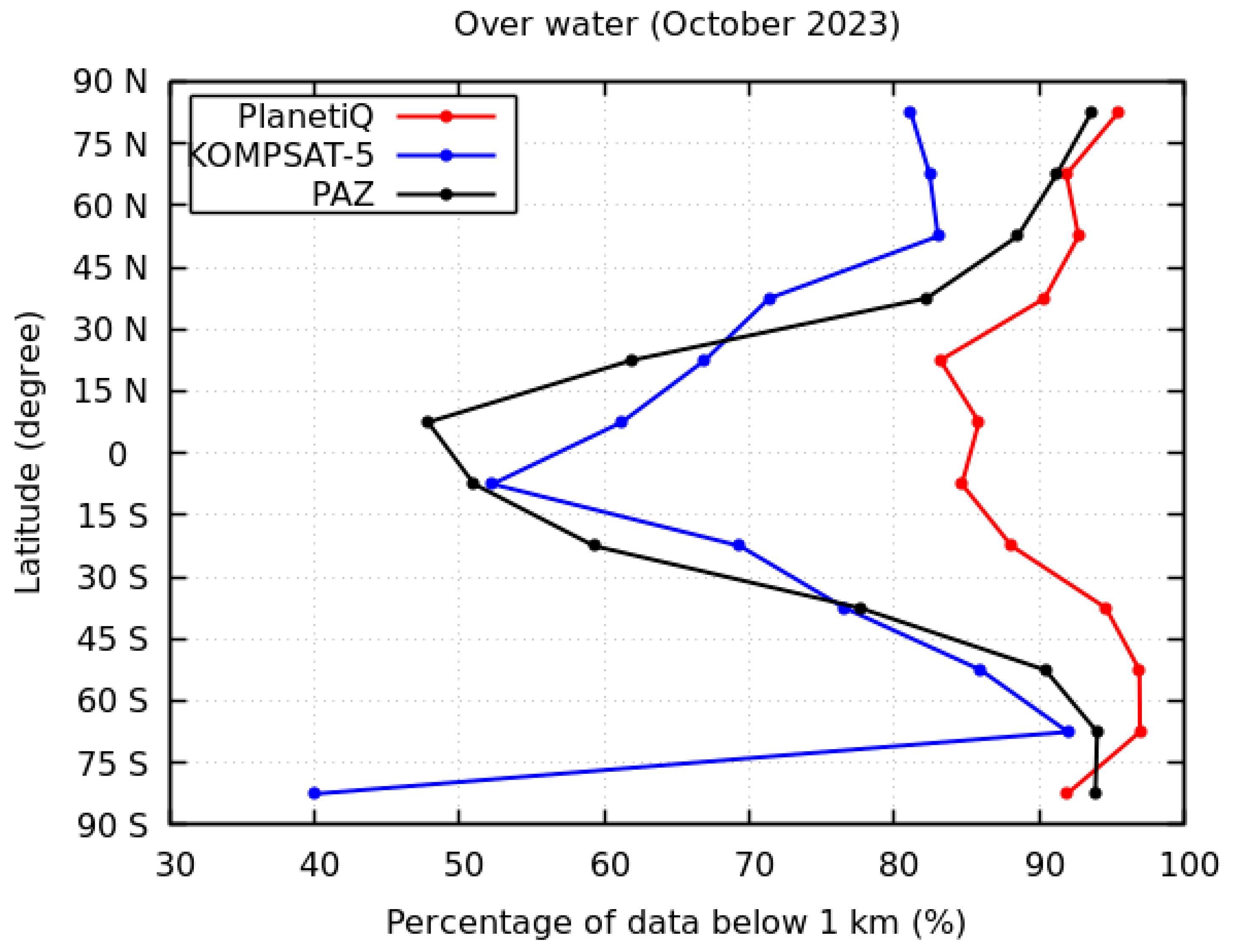
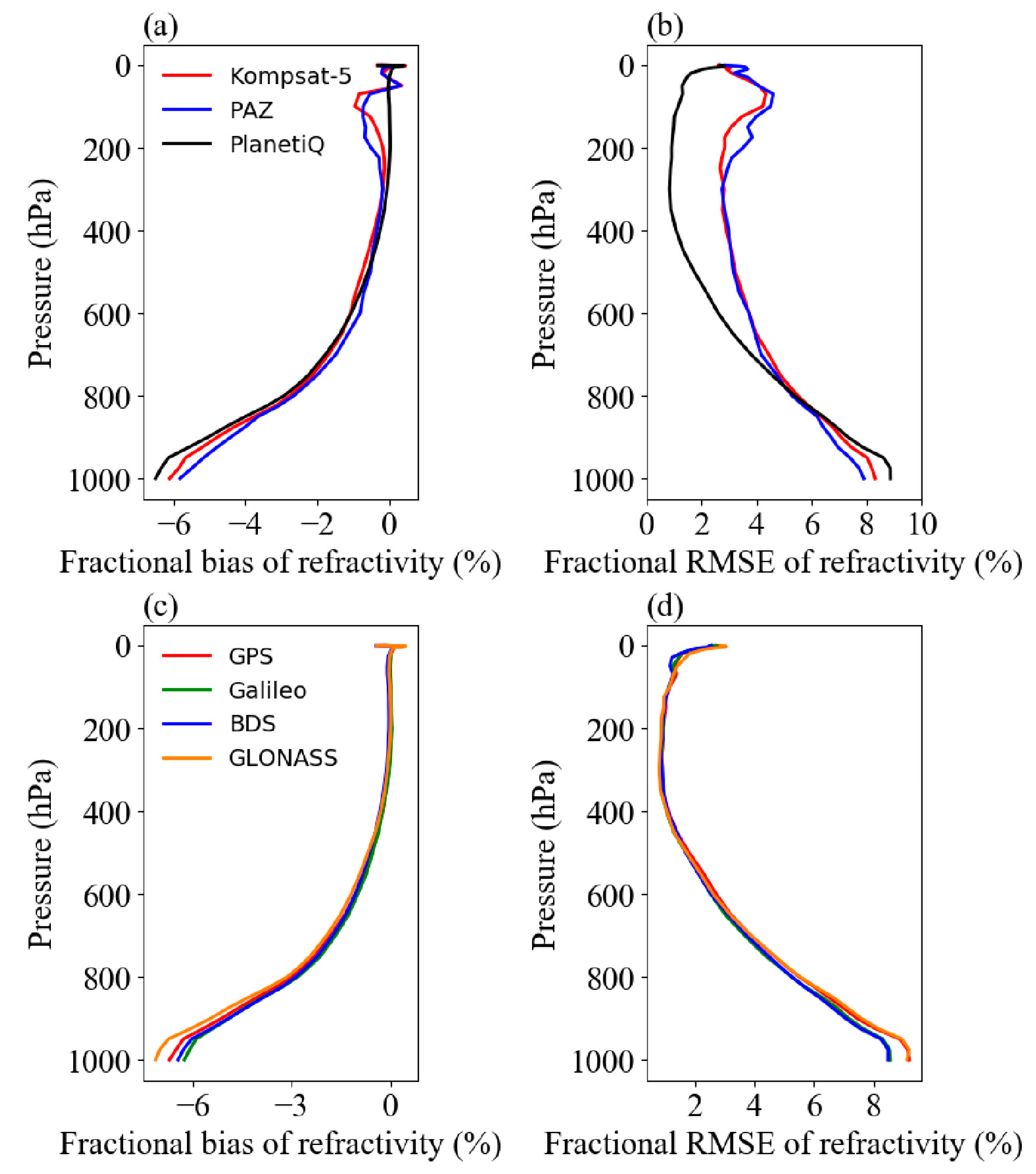


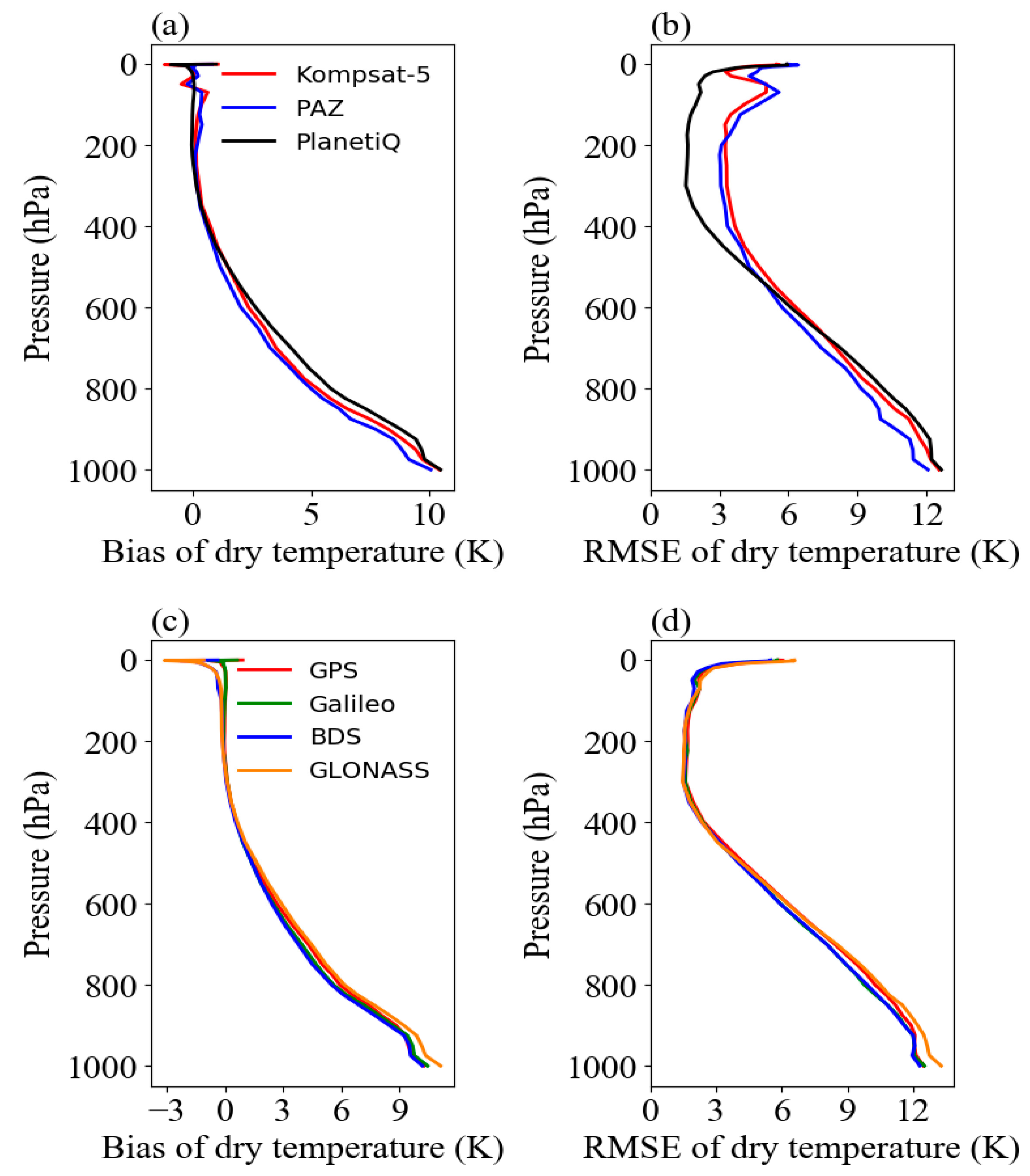
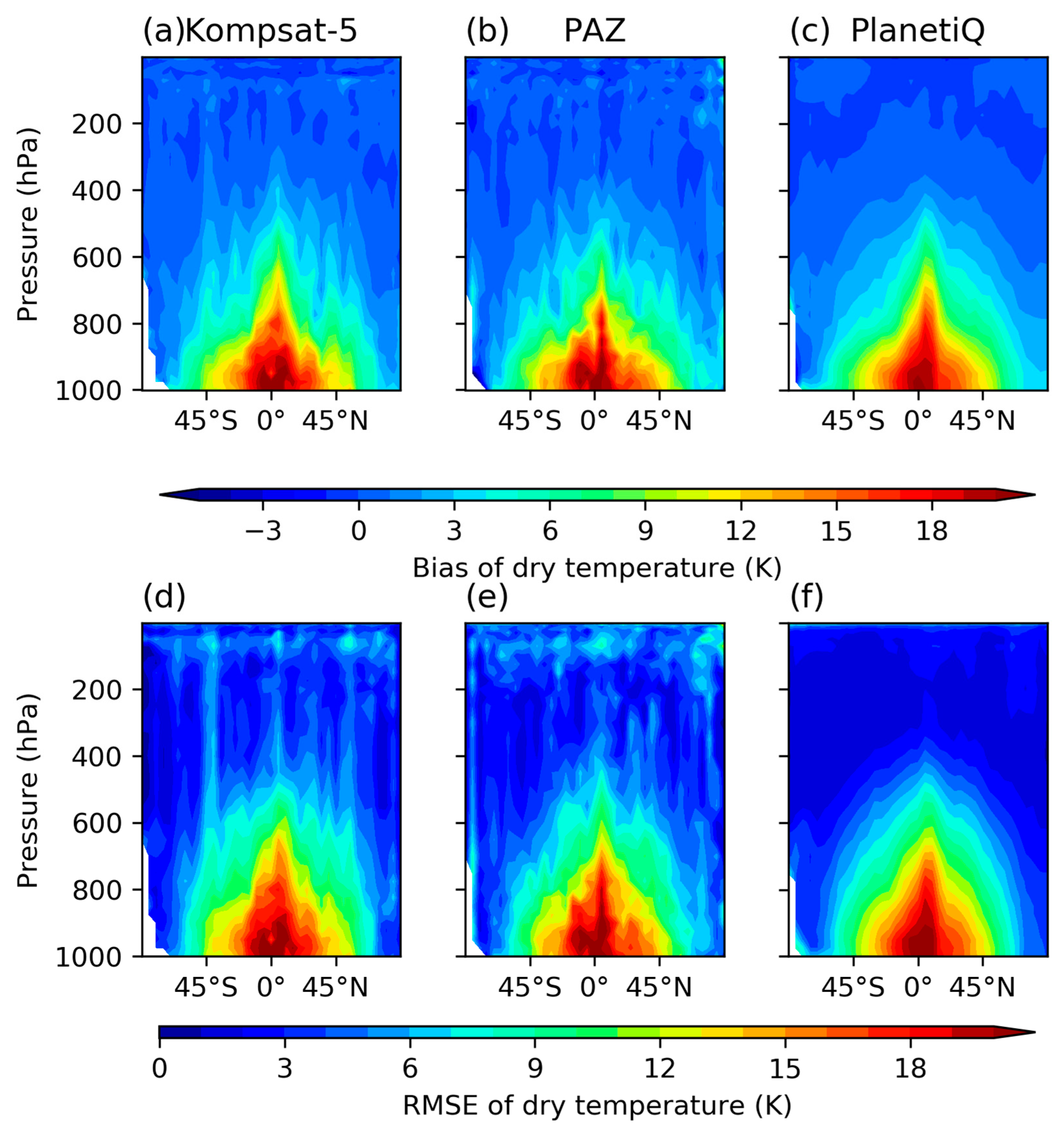
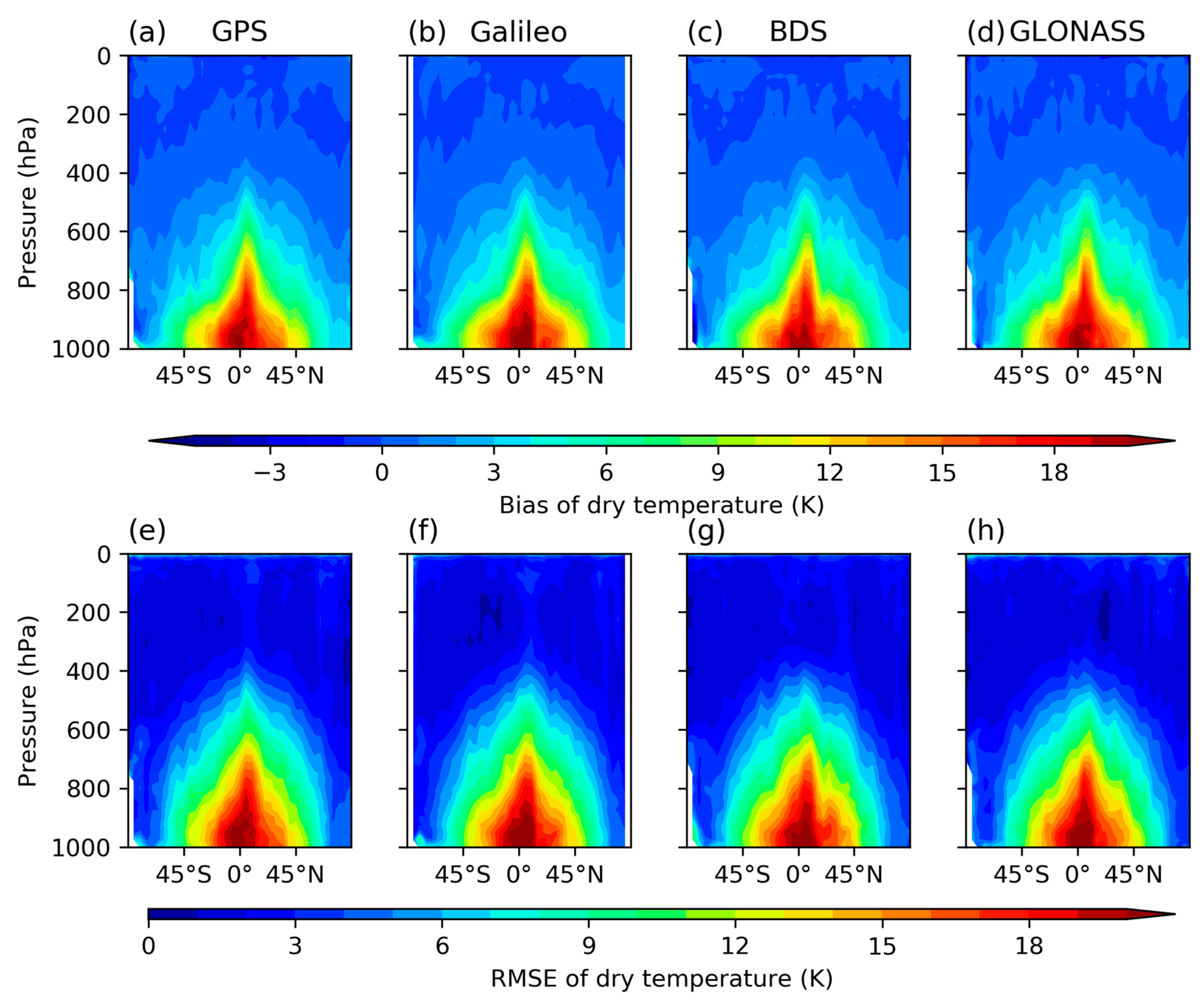
| Mission | 10°S–10°N | 10°N–30°N | 10°S–30°S | 30°N–45°N | 30°S–45°S | 45°N–60°N | 45°S–60°S | 60°N–90°N | 60°S–90°S |
|---|---|---|---|---|---|---|---|---|---|
| PlanetiQ | 0.39 | 0.49 | 0.40 | 0.36 | 0.25 | 0.30 | 0.21 | 0.31 | 0.16 |
| KOMPSAT-5 | 1.89 | 1.22 | 1.13 | 1.09 | 0.87 | 0.61 | 0.72 | 0.64 | 0.45 |
| PAZ | 2.07 | 1.68 | 1.40 | 0.70 | 0.68 | 0.45 | 0.36 | 0.42 | 0.32 |
| KOMPSAT-5 | PAZ | PlanetiQ | |||||
|---|---|---|---|---|---|---|---|
| All | GPS | Galileo | BDS | GLONASS | |||
| Bias | −1.51 | −1.45 | −1.48 | −1.51 | −1.42 | −1.50 | −1.63 |
| RMSE | 4.27 | 4.36 | 3.27 | 3.35 | 3.18 | 3.15 | 3.38 |
Disclaimer/Publisher’s Note: The statements, opinions and data contained in all publications are solely those of the individual author(s) and contributor(s) and not of MDPI and/or the editor(s). MDPI and/or the editor(s) disclaim responsibility for any injury to people or property resulting from any ideas, methods, instructions or products referred to in the content. |
© 2024 by the authors. Licensee MDPI, Basel, Switzerland. This article is an open access article distributed under the terms and conditions of the Creative Commons Attribution (CC BY) license (https://creativecommons.org/licenses/by/4.0/).
Share and Cite
Zhran, M.; Mousa, A.; Wang, Y.; Hasher, F.F.B.; Jin, S. Assessment of Commercial GNSS Radio Occultation Performance from PlanetiQ Mission. Remote Sens. 2024, 16, 3339. https://doi.org/10.3390/rs16173339
Zhran M, Mousa A, Wang Y, Hasher FFB, Jin S. Assessment of Commercial GNSS Radio Occultation Performance from PlanetiQ Mission. Remote Sensing. 2024; 16(17):3339. https://doi.org/10.3390/rs16173339
Chicago/Turabian StyleZhran, Mohamed, Ashraf Mousa, Yu Wang, Fahdah Falah Ben Hasher, and Shuanggen Jin. 2024. "Assessment of Commercial GNSS Radio Occultation Performance from PlanetiQ Mission" Remote Sensing 16, no. 17: 3339. https://doi.org/10.3390/rs16173339






